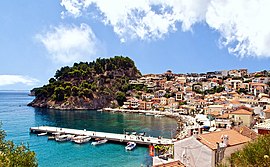Parga
|
Parga Πάργα |
|
|---|---|

View of Parga
|
|
| Coordinates: 39°17′N 20°24′E / 39.283°N 20.400°ECoordinates: 39°17′N 20°24′E / 39.283°N 20.400°E | |
| Country | Greece |
| Administrative region | Epirus |
| Regional unit | Preveza |
| Government | |
| • Mayor | Nastas Antonios (since January 1, 2015) |
| Area | |
| • Municipality | 274.8 km2 (106.1 sq mi) |
| • Municipal unit | 68.9 km2 (26.6 sq mi) |
| Elevation | 32 m (105 ft) |
| Highest elevation | 910 m (2,990 ft) |
| Lowest elevation | 0 m (0 ft) |
| Population (2011) | |
| • Municipality | 11,866 |
| • Municipality density | 43/km2 (110/sq mi) |
| • Municipal unit | 3,904 |
| • Municipal unit density | 57/km2 (150/sq mi) |
| Community | |
| • Population | 2,415 (2011) |
| Time zone | EET (UTC+2) |
| • Summer (DST) | EEST (UTC+3) |
| Postal code | 480 60 |
| Area code(s) | 26840 |
| Vehicle registration | ΡΖx |
| Website | parga.gr |
Parga (Greek: Πάργα [ˈpaɾɣa]) is a town and municipality located in the northwestern part of the regional unit of Preveza in Epirus, northwestern Greece. The seat of the municipality is the village Kanallaki. Parga lies on the Ionian coast between the cities of Preveza and Igoumenitsa. It is a resort town known for its scenic beauty.
The present municipality of Parga was formed at the 2011 local government reform by the merger of the following 2 former municipalities, that became municipal units:
The municipality has an area of 274.796 km2, the municipal unit 68.903 km2.
In antiquity the area was inhabited by the Greek tribe of the Thesprotians. The ancient town of Toryne was probably located here. The village of Parga stands from the early 13th century. It was originally built on top of the mountain "Pezovolo". In 1360 the Pargians, in order to avoid the attacks of the Magrebins, transferred the village to its present location. During that period, with the help of the Normans, who held the island of Corfu, the fortress of Parga was built. In 1401 a treaty was signed with the Venetians, and the rule of Ionian Islands passed to them. The Venetians respected the lifestyle of the Pargians who provided, in turn, invaluable assistance to the fleet of the Venetians. At the same time the Pargians fought by the side of their compatriots to throw off the Ottoman rule. As Parga was the only free Christian village of Epirus, it was a perfect refuge for persecuted fighters and their families. In 1797 the area, along with the Ionian Islands and Parga, fell into the hands of the French, and in 1800, proclaimed free city status with broad authority under the protection of the Sublime Porte. In 1815, with the fortunes of the French failing, the citizens of Parga revolted against French rule and sought the protection of the British.
...
Wikipedia


